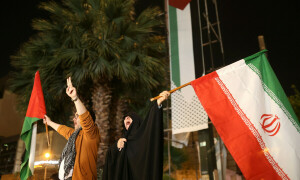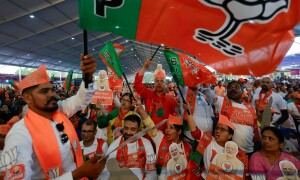One year of Zarb-i-Azb has positively changed Pakistan’s security landscape. Statistically speaking, the frequency of terrorist attacks has gradually declined since the launch of the military operation in North Waziristan on June 15 last year.
The operation has considerably damaged the destructive edge of terrorist groups, mainly the banned Tehreek-i-Taliban Pakistan (TTP). Zarb-i-Azb has achieved its targets in North Waziristan to a significant extent. Yet, it is too early to claim that the terrorists have been defeated.
During this one year, Pakistan has reclaimed its territory from the militants. Many terrorist groups are on the run. The TTP’s infrastructure has been damaged and scattered. Central Asian militant groups are struggling to find appropriate hideouts. If these were the objectives of the military campaign, most have been achieved. Nonetheless, Shawal’s mountainous region on the Pak-Afghan border still needs to be cleared of militants.
However, terrorists are still capable of carrying out major attacks in urban areas of the country, although with lesser frequency. There has been no let up in sectarian-related terrorist attacks. Also, a sense of insecurity still prevails in the tribal areas and parts of Khyber Pakhtunkhwa.
Many new threats have emerged since the launch of the operation.
Of course, the elimination of terrorist networks is not an easy task. Nor can it be done merely through launching military operations in certain areas. That is why the National Action Plan was evolved to deal with the threat holistically.
Many new threats have emerged since the launch of Zarb-i-Azb. The self-styled Islamic State was not in sight when the operation was launched. Al Qaeda was in transformational mode and was working on a change in strategy at the time. Just after the launch of Zarb-i-Azb, Al Qaeda announced the establishment of its chapter in the Indian subcontinent; it was later found involved in some major terrorist attacks in the country. The Islamic State is attracting small urban-based groups and self-radicalised youth. These IS-inspired groups are gradually coming into a position of launching terrorist attacks.
These emerging threats require a reassessment and change in approach. To supplement the gains of Zarb-i-Azb, there is a need to declare 2015-16 as the year of the complete implementation of NAP. The government acknowledges that the implementation of NAP is faltering and there has been widespread public dissatisfaction with the ineffective implementation of the plan.
NAP’s 20 points have a wide scope. The challenges standing in the way of implementing these points are mainly institutional, including lack of capacity of related institutions and departments and also the lack of coordination among civil and military intelligence agencies. Also, lack of political will is a factor. The political leadership has yet to take complete ownership of the country’s war on terrorism. The state’s failure to make the National Counter-Terrorism Authority fully functional is one example of how civilian institutions have remained ineffective in becoming part of a larger internal security policy, which is still strategically guided by the army.
At the same time, it is also vital that Pakistan’s security policy is based on real and factual assessment of threats. In this perspective, let us take a look at the current security situation in different parts of the country.
Although the Zarb-i-Azb, Khyber I and II military operations are in full swing, the militants continue to operate from their scattered pockets in the operation-hit areas of Fata. This implies that the terrorists’ infrastructure is still intact in some areas. The claim is supported by incidents of US drone strikes targeting militant positions in the same regions. The fact that the TTP and affiliated groups have been successful in hitting almost all major areas of Fata and KP during May 2015 (43 attacks killed 61 people in these two regions during the month) suggests that militants still have the capability to hit their targets anywhere in these two areas.
Balochistan’s security is gradually becoming more volatile where many militant, sectarian and insurgent groups are active. Most analysts are convinced that the recent targeted killing of Pakhtuns in Mastung is an effort by Baloch insurgents to send the message that Balochistan is not safe for projects like the China-Pakistan Economic Corridor. Many also see a foreign hand behind this attack, for which a spokesman of the United Baloch Army (UBA) claimed responsibility. Non-Baloch workers in Balochistan are frequently attacked by insurgents, but this attack on the Pakhtun community in Balochistan can create a new conflict in the province — between the Baloch and Pakhtun communities.
There were reports that a Karachi-like operation could be launched in Balochistan after the Mastung killings. It would be indeed a great challenge for the provincial government, the federal government, and the military to evolve and implement a consensus security policy for the province.
Karachi once again experienced a horrible sectarian-related attack last month, this time on members of the Ismaili community. A growing nexus among Sunni sectarian and other local and international terrorist organisations in Karachi is a huge challenge for security agencies. The militant group Jundullah, which initially claimed responsibility for the attack, has a history of alliances with local and foreign militant groups. It has remained very close to the TTP, Al Qaeda and also Lashkar-i-Jhangvi. At one point, it also declared its allegiance to IS. These groups are also making inroads inside other parts of Sindh.
The Rangers and Karachi police have been conducting intelligence-based surgical operations in the metropolis for almost two years. But militants continue to show their presence by carrying out either high-profile targeted killings or terrorist attacks such as the one targeting the Ismaili community. Karachi’s recently formed apex committee — comprising civilian and military representatives — should objectively analyse and respond to the growing insecurity and militancy in the city.
The irregular terrorist activities in Punjab and especially increasing sectarian targeted killings in north Punjab indicate that militants still have bases in the province.
The challenge of terrorism is indeed considerable; but it is possible to meet it through clear threat perception and a coordinated strategy.
The writer is a security analyst.
Published in Dawn, June 14th, 2015
On a mobile phone? Get the Dawn Mobile App: Apple Store | Google Play













































